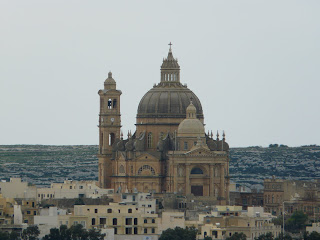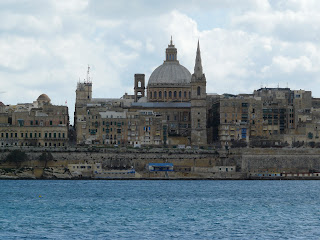The official religion in Malta is Catholicism. We were told that in this small country, there are 365 churches-one for each day of the year. The Catholic church exerts a huge influence on society here. Divorce and abortion are still illegal.
St Paul is the most important saint in Malta. He was reported to have been ship wrecked here in route to Rome. Other important saints are St John the Baptist and St Agatha.
Caravaggio (artist) arrived in Malta in 1607. He impressed the Grand Master of the Knights of St John and was knighted. He painted The Beheading of John the Baptist which is in the St John's Co-Cathedral.
St Paul is the most important saint in Malta. He was reported to have been ship wrecked here in route to Rome. Other important saints are St John the Baptist and St Agatha.
Caravaggio (artist) arrived in Malta in 1607. He impressed the Grand Master of the Knights of St John and was knighted. He painted The Beheading of John the Baptist which is in the St John's Co-Cathedral.
St John's Co-Cathedral from the outside.
St John's Co-Cathedral
Tombstones of some of the knights that are buried in the Cathedral. The entire floor of the church is a sea of multi-colored marble where 400 knights are buried beneath these tombstones.
The Nave. This Cathedral is very ornate. A beautiful building.
One of the chapels of the Langues. There were eight langues (languages--the national chapters) each with its own chapel. The Langues vied with each other to create the most lavish chapel and all were richly decorated. The artwork was outstanding.
Tombstones in the floor
Archway--notice the Maltese Cross
The High Alter at the front of the cathedral.
It is made of gold, silver and bronze, encrusted with precious jewels.
It is made of gold, silver and bronze, encrusted with precious jewels.
Mosta Dome in the city of Mosta
Mosta Dome--officially Our Lady of the Assumption. This dome is the 3rd largest in Europe (or perhaps the 4th - Gozo Island claims to have built a bigger one.)
Inside the Mosta Dome
The Dome
Standing outside of the Mosta Dome with St Jacob
An interesting story about the Mosta Dome--during WWII, a German bomber dropped this bomb on the Mosta Dome. The bomb did not explode but it did knock out the keystone from the center of the dome. The dome should have collapsed but it stayed up. It is considered a miracle.
Many years after the war, the bomber came to Mosta Dome seeking forgiveness
from the people of Mosta. They welcomed him with open arms!
Many years after the war, the bomber came to Mosta Dome seeking forgiveness
from the people of Mosta. They welcomed him with open arms!
St Paul's Cathedral in the ancient capital of Mdina
Another cathedral--they are numerous
A church on the island of Gozo
Another cathedral on the island of Gozo in Malta
There are literally hundreds of churches
Ta' Pinu Basilica--thousands of Maltese people travel here in hopes of Our Lady of Ta' Pinu
curing them of their ailments.
curing them of their ailments.
Ta' Pinu Basilica
Xewkija Cathedral on the island of Gozo.
It is claimed by the Bozitans to have the 3rd largest dome in Europe--disputed by Mosta.
The church is big enough to hold three times Xewkija's population.
It is claimed by the Bozitans to have the 3rd largest dome in Europe--disputed by Mosta.
The church is big enough to hold three times Xewkija's population.































































